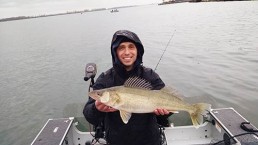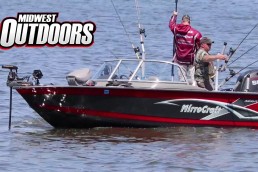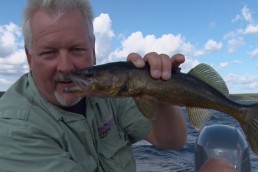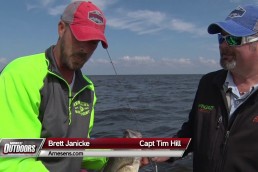Best Baits for Summer Walleye and Bass Fishing
SHARE THIS POST
Opening day brought in fog and limited visibility. We were fishing a lake well known to us and its shoreline had brush, logs, a sandy section and a nice patch of cabbage weeds.
We were fishing a ‘crawler harness minus the spinner. A two- or three-hook harness minus the blade just flutters and dances in the water. One of my favorite rigs is from Cabelas and it uses two Mustad Death hooks. This bait rotates and flutters driving fish nuts.
How you fish this lure will determine your success rate. When the opening day bell rings, the best method is without any weight. Only under windy conditions would I consider a small split shot.
This “do nothing” fishing is the exact manner that Charlie Brewer describes in his book. Cast and retrieve ever so slowly. I rarely cast at a fish but more at an object, like a fallen tree, an overhang limb, or a section of clean bottom in a cabbage weed patch. I also include docks, rafts, logs, stumps, old tires and any place that a bass might be lurking around.
The weightless technique allows the bait to flutter downward to the bottom in an enticing and erratic manner. The free falling movement is easy for a bass to inhale without feeling and pressure.
Once the worm hits bottom, I raise my rod tip up slightly and reel very slowly. You want the worm to crawl over items, lift up slightly, free fall a few inches and move with the current or with gravity. A weighted worm will not do this.
When we move out from the shoreline to fish the weedline, docks or rafts, we use exactly the same presentation. Fishing six to eight feet of water takes a few seconds longer for the worm to reach bottom, but the wait is worthwhile. Often the strike will occur before the worm ever hits the bottom.
eIt is very important to become a line watcher. I allow the worm to sink on a loose line, not a tight line. Most strikes will be a movement of the line to your side. The bass slides in quickly, sucks in the worm and continues moving. If your line moves in this manner before hitting bottom, you must reel in your slack quickly and then set the hook.
We use 6-2 Fireline when fishing this technique. I like using a St. Croix medium-light rod or a fly rod blank. The longer the rod, the better; and the St. Croix panfish series is perfect.
Chasing down walleyes and deep-water bass is best on points. Most points are easy to spot. You can see a portion of the shoreline extending out from shore. However, there are many other points that might not be seen with the naked eye but will show up on a graph or on a topographic map.
An angler could do well just fishing points. I think of Hardy or Croton Pond on the Muskegon River system and the sheer number of points. This fishery is located near Newaygo and loaded with huge smallmouth bass, largemouth bass, a lot of eater-size walleyes and great bluegills. You can run all day from one point to the next and not fish the same location twice. In addition, the old river channel can be real good especially in the fall.
Once we move out to the points and the water is, say deeper than 10 to 12 feet, a blade is attached. Also, once the water warms up to the 60-degree range, both the bass and walleyes get much more active. The Colorado or Indiana blade throws off a nice thump, drawing the attention of a hungry fish. Great pre-made spinners include Northland Tackle, Stopper Lures and my two favorites, the Death Hook rig with a blade or the new Mepps Walleye trolling spinner. A fat, conditioned crawler is key! When the water is cold, the best points are the points extending into a shallow warm bay or cove. As the summer heat takes over, the points extending into the main lake basin produce best.
The points receiving the least amount of sun are best. Watch the sun and fish the points that get hit first with the hot sun rays and make out a milk run. You can hit a set of points early in the morning, then on the opposite side of the lake another set of points. Later in the day, you can go back and hit the first set.
Are you enjoying this post?
You can be among the first to get the latest info on where to go, what to use and how to use it!
On any given point one side of the point might receive more wind or sun than the other side. Walleyes love to sit downwind on a point and let Mother Nature blow unsuspecting baitfish to them.
Walleyes also love shade. Their eyes are designed for low-light conditions. When you are on the water, you can often see one side of the point where it darkens more so than the other side. This is the prime area for a walleye to sit.
Another easy location to fish is a deep cabbage weedbed. Any weedbed can work, but the broad-leaf cabbage weeds are magnets. Walleyes and bass feed in the weeds all day. Some hunker down in a thick mat when the sun is pounding on them, but if the forage is there, walleyes will move in and take advantage of it.
After dark is a killer time, and early in the morning and at dusk are prime times. A limit can come quickly once a school moves in to feed. After dark, cast an un-weighted spinner or use just one number seven split shot. Try reeling over the tops of the weeds. If this fails, cast alongside of the weeds and work it just over the bottom.
The last location is wide open. If you get a day or two with a steady stiff breeze, fish the area getting hit the hardest. If you have a cove or a bay where the wind is blowing in, stop and fish it. Schools of fish will follow the hard winds and gorge themselves on the forage. Once the winds stop or shift, every walleye will pull out and you would never think to fish there again.
During the dog days of summer I will fish deep. Bass are caught in depths between 20 to 30 feet and we landed walleye in depths pushing 80 feet. Hamlin Lake near Ludington, Michigan rates as my top vacation destination. From the sandy beaches of Lake Michigan to the dunes separating Hamlin Lake and Lake Michigan, there is something for the entire family. Hamlin Lake has some of the nicest cabbage weeds found, plenty of nice points to fish and the deep old river channel for the middle of the day summer fishing.
Trolling or drifting requires a near vertical approach. A 45-degree angle should be the maximum. Trolling or drifting covers more water and a better chance at finding active fish. Once a fish is located make several passes over the same general area.
The best speed is slow or slower. Consider a drift sock or two when the winds pick up and throw you all over the place. Good electronics help, and units like my Lowrance pick up the smallest details. You do not need an expensive graph; the least expensive graph is many times better than when I started with the old Green Box.
The first time I tried deep water was in August on Hamlin Lake. A local asked me three times if I wanted to catch some nice walleyes and huge catfish. Each time I said yes. Finally he said fish the old river channel during the mid-day hours. After a decent battle, a nice walleye came from 83 feet of water with a three-ounce bottom bouncer and a floating jig head buried in the corner of its mouth. The bottom bouncer weight has proven valuable over the years for many species.
We tried this technique on Muskegon and White Lake with good results. The best fishing starts in July and continues through September. If your lake is connected to the big lakes or is an impoundment, try the old river channel during the summer.
How do you fish this deep? Use a bottom bouncer or a three-way rig similar to the old Wolf River Rig. In the simplest of terms a bottom bouncer is a sinker on a piece of wire. The weight portion is about half of the way from the bottom. A piece of wire between three to four inches will remain from the weighted portion. When fished correctly this greatly reduces the amount of snags.
The correct method when using a bottom bouncer is to tick the bottom and bounce it up off of the bottom. This up and down motion creates slack in your line and less resistance for the fish. Do not drag the bouncer on the bottom. For extra buoyance, add an inline float or two to get your spinner up and over any bottom debris.
The old-fashioned ‘crawler harness rig is alive and plucking off fish. Get versatile with it and enjoy what might become your best walleye and bass lure—and the least expensive.
MWO
SHARE THIS POST
Did you enjoy this post?
You can be among the first to get the latest info on where to go, what to use and how to use it!
Jack Payne
Jack Payne is an accomplished angler and hunter who enjoys teaching others as much as learning from others. Seminar speaker, outdoor photography enthusiast, hunter safety instructor and volunteer at many events for both kids and adults as an instructor.



